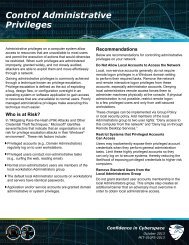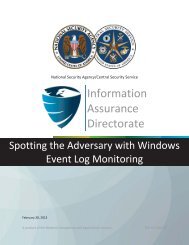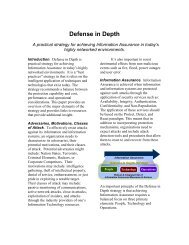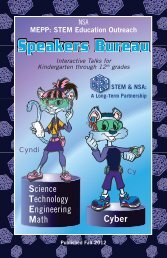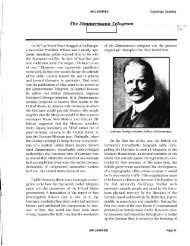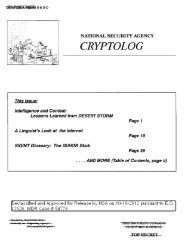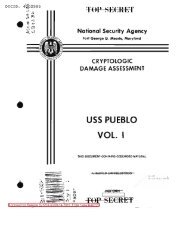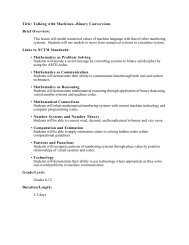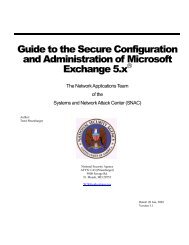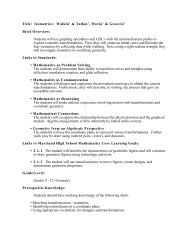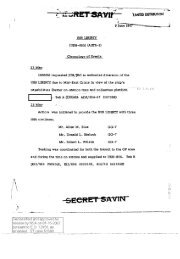Scanned Document - National Security Agency
Scanned Document - National Security Agency
Scanned Document - National Security Agency
Create successful ePaper yourself
Turn your PDF publications into a flip-book with our unique Google optimized e-Paper software.
This is an examination of codes and<br />
ciphers as they figured in American history<br />
prior to the twentieth century, prior to the<br />
era of wireless or radio communication and<br />
the advent of the electronic age. It forms<br />
a backdrop for understanding modern<br />
cryptology and the role of cryptology<br />
(notwithstanding its traditional secrecy) in<br />
the growth of this nation. Our guide is Dr.<br />
Ralph E. Weber of Marquette University,<br />
whose 1979 United States Diplomatic Codes<br />
and Ciphers, 1775-1938 (Chicago: Precedent<br />
Publishing Inc.) established him in the<br />
forefront of students of this arcane subject.<br />
Cryptology, the art and science of code-<br />
making (cryptography) and code-breaking<br />
(cryptanalysis), depends on the prevailing<br />
state of technology and the perception of<br />
threat:<br />
Technology determines the means of<br />
communications. Technology also provides<br />
the means for protecting and the means of<br />
exploiting intercepted communications.<br />
Perception of threat depends upon a<br />
number of considerations, such as the<br />
estimated degree of risk, or the damage that<br />
might occur, should an unintended recipient<br />
become privy to the contents of the<br />
communication.<br />
The perception of threat rises naturally in<br />
war, but it also pertains in international<br />
relations, in business competition, in politics,<br />
and even in personal matters, including<br />
financial transactions. Applying technology<br />
to protect communications (to "mask" them,<br />
to use Thomas Jefferson's term) or to exploit<br />
those of another party introduces other<br />
variables, not the least of which is cost. Cost<br />
can involve dollars of time, including<br />
personal inconvenience. Sometimes the risk<br />
is discounted, if the cost seems too great;<br />
conversely, faced with the consequences of<br />
compromised information, what seemed<br />
Foreword<br />
earlier too great a cost may well be dismissed<br />
in favor of security.<br />
America was born out of revolutionary<br />
conspiracy. One of the principal concerns for<br />
conspirators is communication, keeping in<br />
touch, and doing so in confidence. As rebels<br />
and conspirators, the young nation's leaders<br />
had turned to codes and ciphers in an effort<br />
to prescrve the confidentiality of their<br />
communications. The technology of the time<br />
was that of messenger or hand-written<br />
correspondence, hand delivered, or by<br />
prearranged signals, such as Revere's fabled<br />
lanterns, "one if by land, two if by sea." The<br />
risk was that a dispatch might fall into enemy<br />
hands through capture of a courier, and this<br />
did happen. Intercepted cryptograms yielded<br />
to cryptanalysis of an elementary sort,<br />
producing communication intelligence,<br />
COMINT. But there was no COMINT effort as<br />
we would understand the term today. The<br />
technology of the time would not have<br />
supported such a concept. (How many enemy<br />
couriers could be scheduled for systematic<br />
and regular capture, to justify thought of a<br />
sustained effort?) Nor was cryptography an<br />
organized bureaucracy; rather, it depended<br />
upon the interest, knowledge, and<br />
imagination of a few men. America was lucky<br />
to have such men when it needed them. Some<br />
were "civilians in uniform," volunteer<br />
soldiers; most were learned men, clergy<br />
(familiar with Greek, Latin, Hebrew),<br />
mathematicians, scholars - some were<br />
statesmen. Their involvement in cryptology<br />
was generally brief, but it constituted the<br />
seeds of American cryptology.<br />
With the successful end of the<br />
Revolutionary War, the occasion for<br />
COMINT disappeared, as did the perceived<br />
need for secrecy, in the absence of an<br />
adversary. When the need subsequently<br />
arose, particularly in the case of foreign



